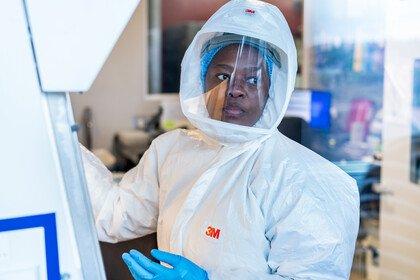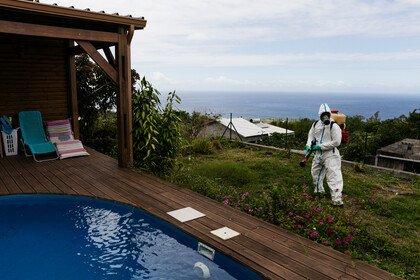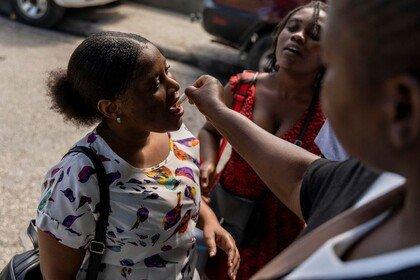
Summary
What is dengue?
- Dengue is an infectious disease transmitted to humans through mosquito bites.
- Several factors are driving a rise in dengue such as climate change and travel.
- Dengue prevention methods exist but they are often not effective enough.
- We need global action to help find effective solutions to fight dengue and protect the billions of people at risk.
Over the last 20 years, there has been a tenfold increase in reports of dengue – an infectious disease that spreads to humans through the bite of infected Aedes aegypti and Aedes albopictus mosquitoes.
A high fever, headache, vomiting and rash are some of the most common symptoms of dengue. In rare and severe cases, it can also cause death. The symptoms become more extreme in individuals with subsequent infections.
Dengue thrives in hot, humid and densely populated conditions. While it is most common in tropical and sub-tropical climates, the disease is now endemic in over 100 countries and can be found on almost every continent.
Roughly half of the world’s population is at risk.
Dengue in numbers
2 vaccines approved for limited use
100 countries where the disease is endemic
100 to 400 million estimated infections occur each year
3.9 billion people are at risk of infection
What’s behind the rise in dengue cases?
In the first two months of 2024 alone, there were reports of more than a million cases of dengue in Brazil. It’s a record for this period, with cases normally peaking from March to May.
Nearby, Peru recorded over 34,000 dengue cases in the first eight weeks of the year. The country declared a state of emergency, and its health minister even resigned in the face of the outbreak.
More than 9,000 miles away from these outbreaks, Bangladesh is also seeing a deadly surge in cases that occur frequently throughout the year. Dengue infections were up fivefold in 2023 compared to 2022.
Countries previously dengue-free or at low risk are also reporting cases. That includes France, Croatia, Afghanistan, Chad and the US. And, in many countries in Africa and Asia where data are limited, the true burden of dengue is unknown.
So, why is dengue spreading across the world? And why are recent outbreaks breaking seasonal trends? There are many interacting factors, including:
Climate change
Warmer temperatures as a result of climate change are making more places suitable for mosquitoes to spread and survive, causing disease transmission seasons to last longer and affecting the behaviour and geographical range of Aedes mosquitoes. Increased rainfall can lead to more pools of water forming and droughts can lead to more people storing water, both of which create more breeding opportunities for the Aedes mosquitoes. They lay eggs in water storage containers like water tanks, buckets or even pet drinking bowls.
Urbanisation and land use
4.4 billion people, or more than 50% of the world’s population, live in cities today. This number is projected to increase to 68% by 2050. Urbanisation can intensify dengue spread, as well as make it harder to implement interventions that help control the disease. Land use can also increase the risk of dengue. Bodies of water, neglected wet grassland and certain agricultural practices have all been shown to influence Aedes mosquitoes’ habitat.
Social demography
There are many studies investigating the link between socio-economic and demographic factors and dengue incidence. This includes an individual’s life expectancy at birth, education, household income and access to broadband. Higher income and better access to healthcare have been found to reduce the risk of dengue.
Travel
Increased international travel and trade in areas where dengue is present can increase the risk of it spreading to new places. For example, in 2023, England, Wales and Northern Ireland reported 634 dengue cases in returning travellers.
Dengue and Zika co-circulation
Dengue can co-circulate in human populations with Zika virus, another infectious disease that’s primarily transmitted by Aedes mosquitoes. They are also cross-reactive, meaning an infection with one virus can affect a person’s immune response to the other. But data on how they interact, particularly in the communities most affected, is limited.
Pressing play on the video above will set a third-party cookie. Please read our cookie policy for more information.
Narrator: This is the dengue virus. If you were infected right now, you might not even notice. But symptoms can range from a high fever to severe headaches and vomiting. Or in the most extreme cases, death.
After a record-breakingly hot 2023, dengue has become alarmingly prevalent. Last year, across Latin America and the Caribbean, there were at least 3.5 million infections, with Jamaica witnessing ten times more than the year before. Bangladesh experienced its deadliest year of infections. And Peru’s health minister even resigned in the face of the country's worst outbreak.
The thing is, 2023 doesn't come as a surprise. Over the last 20 years, reports of dengue have increased tenfold. Roughly half of the world's population is now at risk. So – what’s really to blame for the rise in dengue?
Okay, it's complex. There's lots of interconnected factors. Everything from vaccine access to maybe even the latest El Niño event. But even then, it can still be traced back to the main spreader of the disease: Aedes mosquitoes. Specifically, Aedes aegypti and Aedes albopictus.
These two pretty small species are common culprits when it comes to spreading dengue, alongside other viruses like chikungunya, Zika and yellow fever. With bodies and legs wrapped in stripes, they bite throughout the day, easily transmitting the virus from human to human. These mosquitoes used to live mostly in tropical and subtropical regions where they were found in forests, living in small crevices like tree holds. Today, they can be found on every continent except Antarctica, thriving within towns and cities as successfully as they do in rural environments. So, how have they spread so quickly?
Well – us humans are helping. A combination of growing international travel and urbanisation allows the disease-carrying mosquitoes to reach more places. And they've adapted exceptionally well to their new urban home. Aedes mosquitoes can lay their eggs in water tanks, buckets or bottle caps, even pet drinking bowls. Essentially anything that holds water. They've also become more resistant to insecticides, meaning they're hard to repel and kill. And because Aedes aegypti and Aedes albopictus are active during the daytime, common interventions like bed nets aren't effective.
Of course – there's another factor at play. Climate change.
Dr Felipe Colón-González: Countries with suitable climatic conditions, particularly those in tropical and sub-tropical regions are at higher risk of new populations of Aedes mosquitoes and dengue.
Narrator: This is Dr Felipe Colón-González, Technology Lead, here at Wellcome.
Dr Felipe Colón-González: For example, South East Asia has the highest risk globally. Rising temperatures increase the climatic suitability and the geographic range of Aedes mosquitoes, and so, this expansion can lead to the introduction or establishment of mosquito populations and dengue fever in areas of the world where the disease and the mosquitoes have been absent or have been sporadic.
Narrator: Look at Europe, where changes in temperature and rainfall patterns are affecting the behaviour of the Aedes mosquitoes already as they venture further North and West across the continent. Today, there are nearly triple the number of regions where Aedes albopictus are fully established, compared to a decade ago.
Dr Felipe Colón-González: Changes in rainfall, either through excess rainfall or limited rainfall, can influence for example, water storage practices. If people start storing and collecting more water, that creates opportunities for mosquitoes to thrive.
Narrator: And more Aedes mosquitoes means more transmission potential for the dengue virus. In 2022 alone, the number of locally-transmitted dengue cases reported in Europe was as high as the previous ten years combined. Last year, in 2023, this number jumped even higher to at least 128 cases. But it's not just that they can reach a wider area. They're also staying around for longer, too. Sometimes by months. Bangladesh experienced exactly this. Here, the climate has become increasingly suitable for Aedes mosquitoes to thrive. Over time, the dengue season has become longer and more intense.
Dr Felipe Colón-González: As temperature surpasses 16 degrees celsius, the mosquitoes become more able to transmit the disease. But this relationship with temperature is not linear. So that means that, as temperatures increase, the rate of transmission increases. But if it increases too much, then it starts declining again. So there’s kind of an inverse U-relationship with temperature. And the same you can say about precipitation or rainfall.
Narrator: With these mosquito species able to spread the virus into brand new territory, dengue is now endemic in over 100 countries. And many millions and millions more people will be at risk of dengue by the end of the century.
Thankfully, researchers and teams are working hard to offer solutions. Like Dr Sophie Yacoub, based in Vietnam.
Dr Sophie Yacoub: Dengue control programmes have predominately focused on vector control. But I think this hasn’t been working. So we do need new methods of controlling dengue. And that includes: improving our surveillance systems, we need a comprehensive vaccine programme as well as treatment strategies. Currently we have no treatments for dengue, no antivirals and no host-directed therapies.
Narrator: Early warning systems play a vital role in tackling the rise of dengue, because with enough advance notice, we can limit disease outbreaks. However, whilst many early warning systems for infectious diseases have been proposed, the transition from theoretical to reality is rare. There are projects all over the world aiming to improve this, though.
Dr Sophie Yacoub: We’ve just started a project, it’s called DART, which starts for Dengue Advanced Readiness Tools and it’s a dengue forecasting tool. It’s not only an early warning system for public health institutions, it’s also gonna be one of the first that can warn the general public.
Narrator: These kinds of tools are crucial as we continue to live alongside dengue. Sure, 2023 was intense but this year could be even worse for many parts of the world. Like South America. During the first few weeks of 2024, cases of dengue in Brazil's capital already exceeded the total for the whole of 2023. And a failure to slow global warming will only increase the risk of infection. We need to act faster.
Modelling suggests that cutting emissions, for instance, can significantly reduce transmission in future. When we combine these commitments with further research, vaccine development, innovative mosquito control, and better disease monitoring, we’ll eventually slow the spread, protecting billions of people from dengue.
We’re funding research to better understand what causes and drives infectious diseases to escalate and the solutions to control their impact. Explore our current funding call:
Infectious Disease Award: Understanding dengue and Zika spread, immunity and clinical outcomes
How is dengue prevented and treated?
In most cases of dengue, where the main symptoms are fever and joint pain, it is recommended that individuals treat themselves at home using pain medicine. Those with severe dengue often need hospital care.
There is no specific treatment for dengue, but researchers are working hard to change that.
So far two vaccines have been approved for use: Dengvaxia and QDenga. Dengvaxia has a 60 percent efficacy rate and can help protect people aged 6 to 45, who have previously been infected, against symptomatic dengue. QDenga has a 73 percent efficacy rate against symptomatic dengue and can be given to people over four years old. A third vaccine, TV003, is currently being tested in Brazil.
There are also several traditional methods to prevent and control dengue. Insecticides, window screens and mosquito nets can help protect against mosquito bites, and covering water storage tanks can help stop mosquito breeding. However, there is evidence that some mosquitoes have become more resistant to insecticides, and the Aedes aegypti and Aedes albopictus mosquitoes move during the daytime when bed nets aren’t as effective.
That’s why newer methods are in development, like early warning systems which can limit disease outbreaks, house paint made with insecticide and a preventative pill that is being tested in Phase 2 trials. At Wellcome, we’re funding some of these novel interventions – from a new digital tool that could help predict outbreaks as early as two months in advance to genetically modified mosquitoes that carry a gene that stops their offspring from developing into adults.
While these vaccines and methods exist, they are failing to meet the needs of everyone affected by and at risk of dengue.
To prevent and control dengue, it’s crucial to make sure that the products to detect, prevent and control it are accessible, affordable, available and appropriate for everyone.
For example, there’s a need to scale up vaccine production. Although Brazil became the first country to roll out a public dengue vaccination campaign this year, there aren’t enough vaccines to protect its population of 214 million people. Individuals need two doses each and there are only six million doses.
There’s also a need to address the lack of other resources, including diagnostic kits for early detection, trained clinical professionals, vector control staff and community engagement interventions.
More research, funding, disease surveillance and global collaboration are needed to better understand how dengue spreads, its impact on human health – and how to develop more effective products to prevent and control it.
This needs to be combined with urgent action to mitigate climate change as cutting emissions could significantly reduce disease transmission and help protect billions.
How is Wellcome supporting the fight against dengue?
Infectious diseases like dengue are one of the biggest health challenges the world faces today. Poor and disadvantaged individuals and communities are more impacted than others, yet most advances originate in the global north which often means they reflect the needs of people living in richer countries.
At Wellcome, we want to help change that and help improve the lives of the billions of people at risk. We’re funding research to understand how dengue emerges and spreads, and to speed up the discovery and development of solutions to help.
Over the years, we’ve supported many initiatives including:
- The World Mosquito Program which releases mosquitoes that carry Wolbachia, a bacterium that reduces their ability to transmit dengue and other mosquito-borne viruses. The programme, which we’ve helped fund since 2014, has protected over 11 million people and prevented more than 600,000 dengue cases in 14 countries. This success has led to regulatory approval for the use of Wolbachia in the USA, Australia and Brazil.
- The Vaccine Impact Modelling Consortium, which models the public health impact of vaccination programmes and the impact of climate change on dengue and other climate-sensitive, vaccine-preventable diseases. These estimates are used to understand impact at both a local and global level, and to inform policy and decision making.
- Funding researchers investigating dengue across three of our research programmes: Infectious Disease, Climate and Health, and Discovery Research. Some examples of recently funded projects include ClimateBuzz, a study on the links between climate, land use and mosquito-borne disease risk in Tanzania, and IDExtremes, a modelling tool to predict the probability of infectious disease outbreaks given compound extreme climatic events.
We’re also funding teams to generate evidence on the co-circulation and cross-reactivity of dengue and Zika – and to help implement effective interventions that reduce their burden. This funding, which is currently open for applications, will be led or co-led by researchers in an African or Asian country that’s currently experiencing a dengue or Zika outbreak, or has experienced an outbreak in the past. We believe that funding research in the places most at risk, as well as generating more data where it is limited, will help ensure that any resulting interventions meet the needs of the communities most affected by dengue and Zika.
Dengue's escalation in recent decades is proof of the pressing action needed to control it. Mosquitoes don’t respect borders and it is increasingly likely that the threat of dengue will spread to other communities. Global problems like this require global action. All countries need to work together to find innovative, effective solutions that are responsive to the longer-term, local needs of people at risk of dengue.



